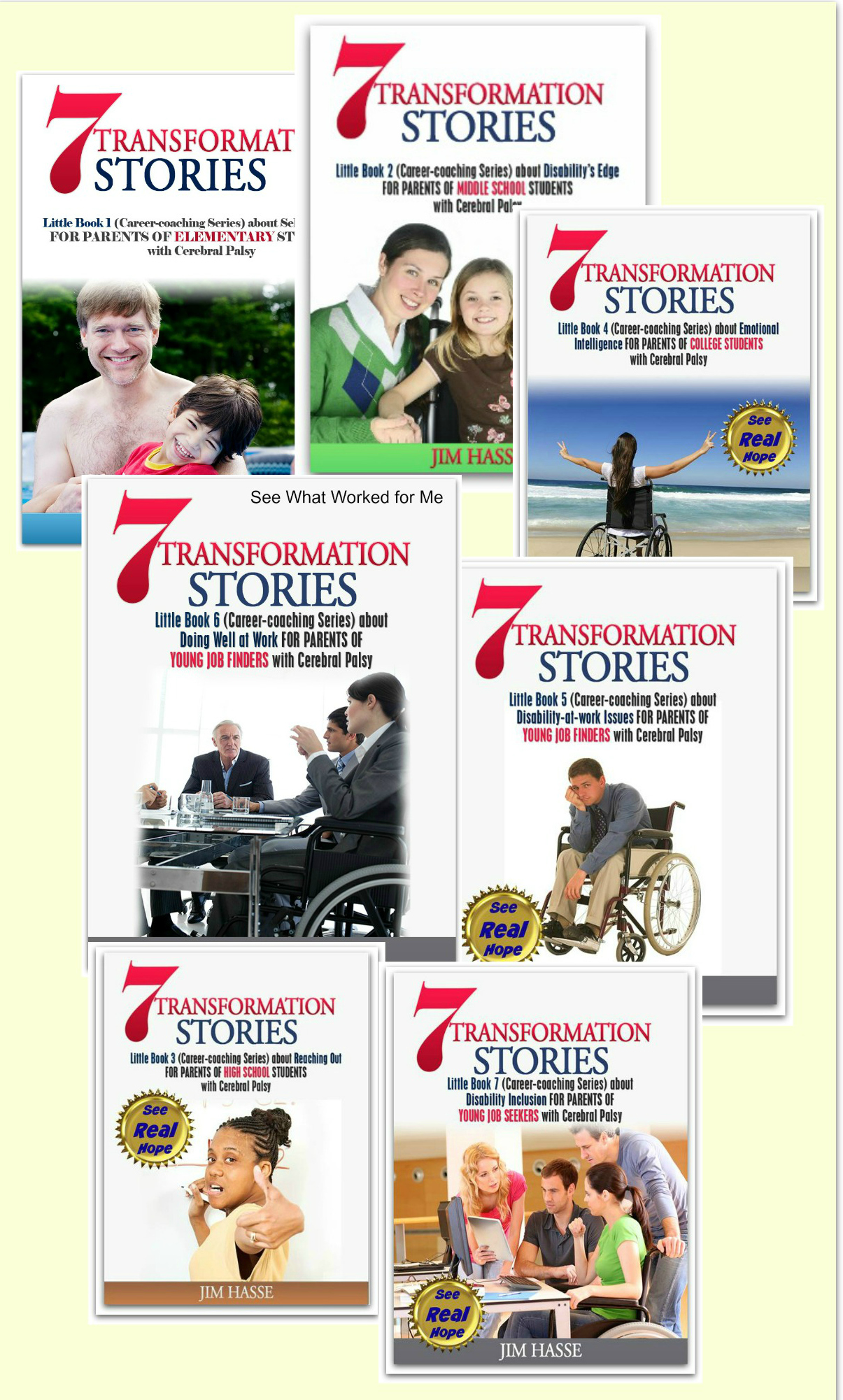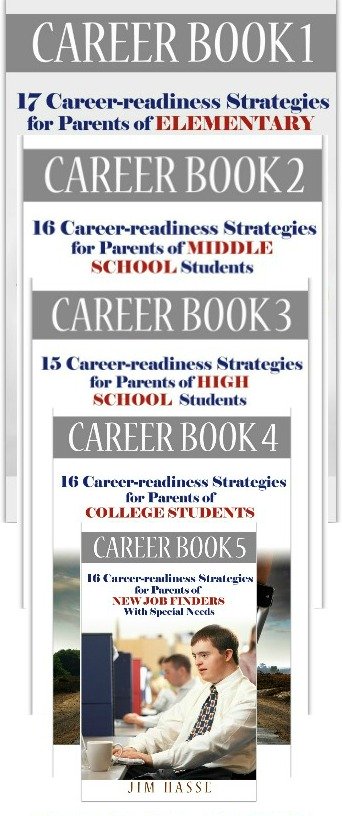How to Manage Fear: Cerebral Palsy Career Builder for Elementary Students
By Jim Hasse, ABC, GCDF, Disability Employment Expert
_________________________________________________________
How to manage fear: Sometimes I feel my life could be summarized by those four simple words.
In fact, if I had to select one word which describes what it’s
like to grow up with a lifelong disability such as cerebral palsy (CP), it
would be “fear.”
However, I remember my dad saying he was shy as a kid but that he gradually grew out of it. So, I’m not sure if my insecurity is in my gene pool, in how I was raised or in how I personally reacted to my CP.
For years, I held my fear inside, and, when I was about 10 years old, I truly felt I was psychologically unstable because I didn’t how to manage fear and I never discussed it openly with my parents.
I told no one that I feared I was psychologically unstable because I was afraid a good deal of the time when I was outside my “safe” environment (i.e. home). My insecurity was producing a fear that something was “wrong” with me because I was afraid once outside our home environment.
All I know at this point is that how to manage fear is a challenge your elementary student with CP is probably facing, even though you may not recognize it at first as a parent, mentor or coach.
Try to find ways your youngster can express his or her feelings of insecurity – through drawing, diaries, play acting, casual chats etc. The key here is to let him or her know that learning how to manage fear is part of the journey in “growing up.” It should not evoke shame, quilt or punishment.
What ways have you found work best
in helping your child express
his or her feelings of insecurity?
Join
the CP Warrior discussion.
Perhaps sharing my personal story with your youngster would be helpful in at least opening a conversation with him or her about how to manage fear.
 Photo courtesy of www.thecuttingedgenews.com.
Photo courtesy of www.thecuttingedgenews.com.How to manage fear: My struggles
As a child, I feared being left by my parents with others -- even with a familiar baby sitter.
I remember the panic I felt one evening when I was left in a church pew alone because my parents temporarily stepped out of the sanctuary.
In grade school, I feared walking down the aisle of any public forum (movie theatre, church, school etc.) because I would picture myself falling in front of the crowd due to my stiff legs and the pitiful stares I would get from onlookers because of my CP.
In high school, I clung to the hallway lockers for fear I would be trampled by the bigger, more “normal” students, especially the guys in black leather jackets and ducktails (yes, it was the 1950s). I also had an aversion to three-foot wastebaskets because one time a fellow student (a hefty Wisconsin farm girl) had to fish me out of one. I had grabbed it for balance and, instead, flew head first (and arms) into the trash.
The summer before my first year in college, I silently cried in the back seat during a family car trip out West when my mom reminded me that my first college classes started in just three weeks. I knew I wasn’t ready to face that new environment, and I dreaded even thinking about it during a carefree (and safe) summer vacation.
During college, I settled into a comfortable routine but worried about how I would fare after graduation when I would enter the rough and tumble “real world.” Real-world business people, I thought, would hear my slurred speech and immediately discount my intelligence and training. And, I wouldn’t be able to get a job.
But, for me, failure, at that point, was not an option. In my experience, there was no advantage to failure. By growing up on a farm, I knew what a crop failure meant: less feed, less milk, less income, less freedom.
As a young person with CP, I needed to earn an income
to become independent -- to be the first in our family to get a non-farm job.
Yet, once on the job, I feared being suffocated in unchallenging work within a
“going nowhere” company in a back-water rural area.
How to manage fear: Success and recognition helped me
But, by the time I became 30 years old, I began to realize some success (and recognition by others) in my work as a corporate communicator, and that helped me learn how to manage my fear.
I
found that people generally don’t think much about what makes others
“different” because they are often preoccupied with their own concerns. And, I
learned that organizations, especially my employer, tend to change through one
“pocket” at a time instead of top down (at the leadership of the CEO, for
instance).
Now that I look back on my career, my “false” fears
of failure may have actually crippled my growth. Yet, on the other hand, I’m probably
stronger now because I experienced that struggle.
We are crippled by false fears when we experience
failure in advance of its actually happening (and that failure may never
happen), according to Seth Goden, whose book, “Poke the Box,” is a call to act
on personal initiatives.
Goden says leaders tend to be more fearless than
their followers. Followers, heeding the voices in their heads, tend to believe
there is no advantage to failure, and, as a result, are stuck in old behavior
patterns. Leaders, on the other hand, understand that learning comes from
failure.
“Nobody is successful all the time, and fear is not
productive. You need to show up again and again and keep playing the game,”
emphasizes Goden, who has had 13 books on the New York Times “Best Seller”
list. He says his first book, by the way, was rejected by 900 publishers.
Successful 20 percent of the time
Goden explains that a person is usually successful 20 percent of the time in any endeavor. “Keep track of your chances,” he recommends. “Your next effort may be the time you’ll be in the 20 percent category.”
That’s one challenge I’d recommend passing along to your youngster: How to manage fear by anticipating that he or she is right now within the 20 percent range of success (after so many unsuccessful attempts).
Goden notes the job market has changed. “There are no more paper-shuffling jobs that pay $150,000 a year,” he says. “Obedient cogs (in the wheel) are being replaced by individuals who are willing to be accountable and to face failure and to take an entrepreneurial approach to work. They are innovative and willing to take risks.”
What really resonates with me is Goden’s admonishment to “believe in your ability to shine a light for people and share what you know that is beneficial to others.” The key, he points out, is accumulating ideas, beliefs and information that stand out from the crowd and people find useful.
The workarounds for fear (which are actually methods for how to manage fear) that I have developed for myself over the years turn out to be a response to that charge. I have learned how to be an innovator and a delegator.
As an innovator, I noticed that people within my workplace were often more intrigued by my creativity, even though my ideas may have turned out to be half-baked and not workable at all. At least, they saw that I was thinking -- and thinking in terms of the company’s success. Once the company’s bottom line became the focus, my CP (and my timidity) seemed to disappear.
For instance, I worked for a dairy processing cooperative which manufactured commodity cheese in bulk for major food companies. As an upstart during the early 1980s, I found myself asking why, as a highly regarded cheese manufacturer, we should not tap into the value-added portion of the cheese business by developing our own brand and marketing channels so our dairy farmer members could reap increased returns from the milk they produced.
And, as a member of senior management during the 1990s, I was plugging away at the same “value-added” orientation -- only this time as the point person for the organization’s strategic planning process.
We were still in the commodity cheese business, but we had developed a whole new value-added product offering: whey products for pharmaceuticals, bakeries, infant formula etc.
In short, I found my CP didn’t much matter, if I shifted the focus to innovation. Creativity trumped my CP and deflected any concerns my colleagues may have had about it. And, that made it easier for me.
As I assumed more responsibility and moved into senior management, I also learned how to delegate hands-on work -- especially work that was difficult for me because of my disability.
I started hiring high school students for after-school jobs and then began to offer paid internships for college students. As the organization and my responsibilities grew, I eventually developed a team of five people, each of whom had authority to carry out specific duties (and get the recognition for it).
Over a 28-year span, I hired, trained and developed more than 25 people in the field of corporate communication, public relations and member relations. And, I learned to welcome failure in myself and others because it helped our team grow.
My lack of knowledge about how to manage fear -- my fear of what could happen (and often doesn’t) because of my CP -- has gradually disappeared.
What ways have you found work best
in helping your child express
his or her feelings of insecurity?
Join
the CP Warrior discussion.
Return from How to Manage Fear to Job Titles
Go to Cerebral Palsy Career Builders
This is Creative Commons content. You can freely and legally use, share and repurpose it for non-commercial purposes only, provided you attach this sentence and the following attribution to it (including the two links):
Originally written and illustrated by Jim Hasse, ABC, GCDF, owner of Hasse Communication Counseling, LLC, who, as a person with cerebral palsy, served for 10 years as a vice president in a Fortune 500 company during his 29-year career in corporate communication. He’s an Accredited Business Communicator, certified as a Global Career Development Facilitator and author of 14 Amazon books about disability awareness and disability employment issues.





